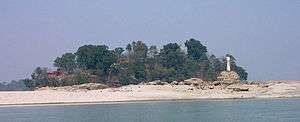Umananda Island

Umananda Island (from Assamese Uma, another name for the Hindu goddess Parvati, the wife of Shiva; and ananda, "happiness") is the smallest river island in the midst of river Brahmaputra flowing through the city of Guwahati in Assam, a state in northeast India. The British named the island Peacock Island for its shape.
Mythology
According to Hindu mythology, Shiva created the island for his wife Parvati's happiness and pleasure. Shiva is said to have resided here in the form of Bhayananda. According to a myth in Kalika Purana, Shiva burnt Kamadeva with his third eye on Umananda when he interrupted Shiva's deep meditation, hence its alternative name Bhasmachal (Assamese: bhasma, "ash"; and achal, "hill"; literally, "hill of ashes").
History
According to history, in the year 1694, the Ahom king Supaatphaa ordered his minister Gargaya Handique Phukan to build a Hindu temple, called Umananda Temple. In 1897, an earthquake damaged the temple heavily, but was later repaired by a local merchant. The temple displays mixture of both Hindu Vaishnavism and Shaivism. There are Assamese craftings of Ganesha, Shiva, Parvati, Vishnu, and other Hindu deities. During the repairing work of the temple some new Vaishnavi scripts were written on the walls. Craftsmen also carved figures out of rock on the island.
Festivals
Maha Shivaratri is widely celebrated in Umananda. Monday is considered to be the holiest day in the temple and the new moon brings bliss to the pilgrims.
Biodiversity
Umananda Island is the home to the species of golden langur.
| Wikimedia Commons has media related to Umananda Island. |
Coordinates: 26°11′47″N 91°44′42″E / 26.19639°N 91.74500°E